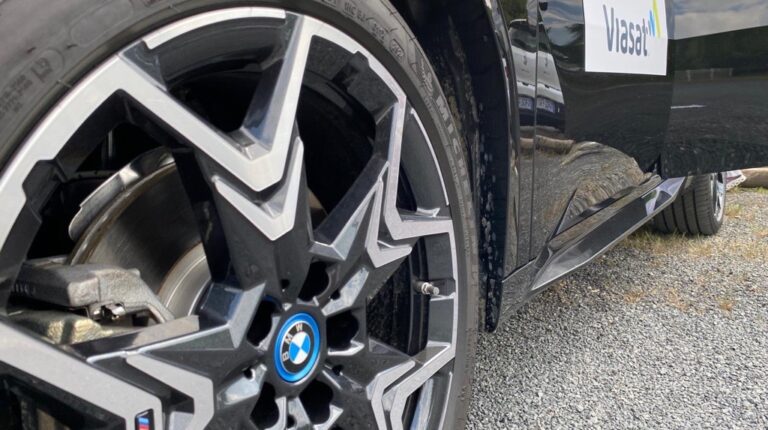The 5G Automotive Association (5GAA) has conducted a world-first demonstration showcasing connected vehicle technologies, at a showcase in Paris, France. This included the use of non-terrestrial networks (NTNs) for transmitting emergency messages and 5G-V2X Direct communication for detecting vulnerable road users (VRUs) in real traffic conditions. Additionally, 5GAA members highlighted the current capabilities of vehicle-to-network (V2N) services.
“Today, we saw real vehicles on real roads, connected through cutting-edge technologies such as satellite, 5G -V2X Direct and commercial networks. This is the future of automotive connectivity, and it’s closer than you think,” said 5GAA chairman Christoph Voigt.
NTN satellite connectivity
The 5GAA members involved in the demonstrations were vehicle manufacturers BMW Group and Stellantis, and technology partners Anritsu, Cubic³, Deutsche Telekom, Harman, Jember, LG Electronics, Qualcomm Technologies, Rohde & Schwarz, Rolling Wireless, Skylo, Vedecom Institute and Viasat.
Demonstrations focused on realizing in-vehicle integration of hazard warning and emergency messaging use cases, as well as illustrating that NTN can complement terrestrial 4G and 5G networks in the future. Also highlighted were in-vehicle integration and seamless switching between NTN and terrestrial networks to enable voice communication.
According to the 5GAA 2030 Roadmap, the initial market deployment of satellite connectivity in vehicles is expected by 2027 (based on IoT NTN 3GPP release 17).
Safety, innovation and connectivity
Anritsu, Keysight Technologies, Rohde & Schwarz and MediaTek complemented the NTN demonstrations with parallel test equipment measurements for performance verification. For the first time on the road, 5GAA member Valeo, in collaboration with Marben, demonstrated 5G-V2X Direct, in which two vehicles shared sensor data, triggering a warning of a pedestrian crossing at an obstructed intersection. This demonstration illustrated how 5G-V2X Direct (based on 3GPP Release 16) will give vulnerable road users advanced protection by leveraging sensors and camera feeds from other vehicles to alert drivers, paving the way for smarter mobility. As per the 5GAA Visionary 2030 Roadmap, 5G-V2X is expected to be mass-deployed in commercial vehicle models starting from the time horizon 2026-2029.
The public road demonstrations showcased V2N technology for road users’ protection. 5GAA members, including Nokia, Orange, Stellantis, Valeo, and Vedecom Institute, showcased interoperable V2X platforms with vehicles, mobile applications and smart intersections (equipped with cameras and connected via the 5G networks) sharing collective perception to enhance road users’ safety.
Additionally, Harman and U-Blox showcased emergency electronic brake light (EEBL) near-real-time alerts to prevent hard braking events, in line with the upcoming 2026 Euro NCAP local hazard requirements, and made use of precise positioning to prevent false alerts.
5GAA members Rohde & Schwarz, SEA, Keysight and Orange also exhibited Next Generation Emergency Call (NG eCall) verification and network performance. The event, hosted by Telecom-Paris, highlighted how 5GAA is developing new standards for safety and innovation in automotive connectivity in Europe and globally.
In related news, Perrone Robotics and NEORide, a council of governments representing more than 30 US transit agencies, recently announced a vehicle-agnostic kit services agreement to retrofit six 35ft Gillig buses in Ohio with Perrone‘s Tony ADAS retrofit kit. Click here to read the full story


